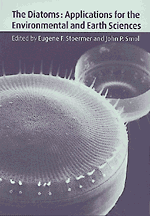Book contents
- Frontmatter
- Contents
- Contributors
- Preface
- Part I Introduction
- Part II Diatoms as indicators of environmental change in flowing waters and lakes
- Part III Diatoms as indicators in extreme environments
- 9 Diatoms as indicators of environmental change near arctic and alpine treeline
- 10 Freshwater diatoms as indicators of environmental change in the High Arctic
- 11 Diatoms as indicators of environmental change in antarctic freshwaters
- 12 Diatoms of aerial habitats
- Part IV Diatoms as indicators in marine and estuarine environments
- Part V Other applications
- Part VI Conclusions
- Glossary, and acronyms
- Index
10 - Freshwater diatoms as indicators of environmental change in the High Arctic
Published online by Cambridge University Press: 16 January 2010
- Frontmatter
- Contents
- Contributors
- Preface
- Part I Introduction
- Part II Diatoms as indicators of environmental change in flowing waters and lakes
- Part III Diatoms as indicators in extreme environments
- 9 Diatoms as indicators of environmental change near arctic and alpine treeline
- 10 Freshwater diatoms as indicators of environmental change in the High Arctic
- 11 Diatoms as indicators of environmental change in antarctic freshwaters
- 12 Diatoms of aerial habitats
- Part IV Diatoms as indicators in marine and estuarine environments
- Part V Other applications
- Part VI Conclusions
- Glossary, and acronyms
- Index
Summary
Introduction
High arctic environments have received increased attention over recent years, as polar regions are considered to be especially sensitive to the effects of global climatic and other environmental changes (Walsh, 1991; Rouse et al., 1997). For example, potential warming from ‘greenhouse gases’ is expected to be accentuated in the High Arctic (Roots, 1989). Other environmental changes, such as increased ultraviolet (UV-B) light penetration and deposition of airborne contaminants, have also been noted recently in high latitude regions (e.g., Landers, 1995).
There is considerable potential for using living and fossil diatom assem blages for tracking environmental trends in high arctic regions (Smol & Douglas, 1996). However, to date, relatively few studies have been completed on the taxonomy, ecology, and paleoecology of high arctic, freshwater diatoms, even though lakes and ponds are dominant features of most arctic landscapes. For example, about 18% (by area) of Canada's surface waters are situated north of 60° N (Statistics Canada, 1987), and Sheath (1986) estimates that tundra ponds cover approximately 2% of the Earth's surface. The heightened interest in high arctic environments, coupled with increased accessibility (e.g., with helicopter support) of these remote regions, has resulted in a recent surge of interest in arctic diatom research. Moreover, proxy techniques such as palynology and dendroecology have some serious limitations in high arctic regions due to the paucity of higher plants (Gajewski et al., 1995). Consequently, paleolimnological approaches using diatoms may become especially important for studies of global environmental change.
- Type
- Chapter
- Information
- The DiatomsApplications for the Environmental and Earth Sciences, pp. 227 - 244Publisher: Cambridge University PressPrint publication year: 1999
- 75
- Cited by



